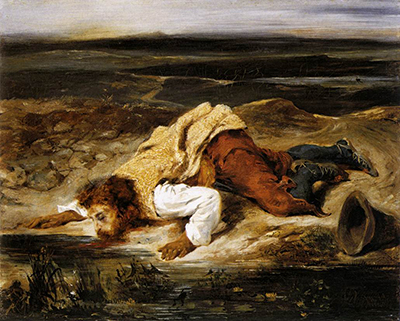Here we find a depiction of the desperate scenes found in war, as a wounded soldier finds a moment of solace by a small river. His injuries are considerable and the outlook bleak as he attempts to rest after a ferocious battle.
This artwork is dated at 1825 and whilst not being one of the artist's more famous paintings, it offers an interesting insight into the influences that led his own style. For example, the vivid colours and brushwork are reminiscent of Venetian artists and also Peter Paul Rubens, both of whom were major contributors to the developed style used by Delacroix. The original painting has brighter tones than perhaps are indicated by the image here, with red hair on the soldier himself as well as a brighter tone of brown for his trousers. He looks vulnerable here, showing the horrors of war that so many artists have covered over the centuries. His beard drapes into the water as he drinks for his own health. He lies on a barren patch of land, surrounded by water in every direction. He appears to have been entirely abandoned, perhaps presumed dead or instead displaced from the original battle as he attempts to protect his own fragile health.
Wounded soldiers have been featured within art just as much as the victorious knight, both being emotive and inspiring themes offering the alternative viewpoint of war and battle. Prior to Delacroix was the work of Neo-classicist, Jacques Louis David, as well as Romanticist Gericault, who tackled both of these opposing viewpoints within their work. Compare, for example, Napoleon Crossing the Alps from David with Gericault's The Wounded Cuirassier to see how different atmospheres could be created by adapting the context of the individual portrayed.
This painting can be found within the collection of the Kunstmuseum Basel. They do not have much else on Delacroix there, with most of his artworks remaining in different locations around France, but there is still plenty to enjoy here with many other notable artists represented. Their highest profile item might be a good selection of Hans Holbein paintings, as well as the much more modern Senecio by Paul Klee and also a number of French impressionist artworks. The collection was established as early as 1661 but there have been several different locations used in the centuries since. There have been a combination of private purchases and bequethed items to create the list of many thousands of items that can now be found under their ownership.
"...The colour of this piece is as beautiful as some landscape imagined by Byron as the setting for the bloodstained body of one of the tyrants of Missolonghi..."
Art critic upon its unveiling




